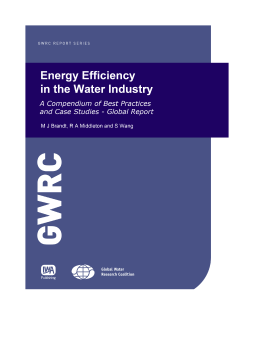
Additional Information
Book Details
Abstract
Available as eBook only.
Over the last decade, energy consumption by the water sector has increased considerably as a consequence of the implementation of new technologies to meet new potable water and effluent quality standards. The price of energy has also substantially increased and these increases will be compounded by the need for additional energy intensive processes to achieve more exacting regulatory requirements.
This GWRC Compendium draws together the best practice in energy efficient design and operation of water industry assets. Energy Efficiency in the Water Industry identifies the developments and future opportunities by detailed examination of current best practice and technologies.
It illustrates:
- Incremental improvements in energy efficiency through optimisation of existing assets and operations
- More substantial improvements in energy efficiency from the adoption of novel technologies
- Successful case studies based on results of full scale operations
Table of Contents
| Section Title | Page | Action | Price |
|---|---|---|---|
| Cover page | 1 | ||
| Title page | 3 | ||
| Copyright page | 4 | ||
| Table of Contents | 5 | ||
| Global Water Research Coalition | 6 | ||
| Acknowledgement | 7 | ||
| Foreword | 8 | ||
| Executive Summary | 9 | ||
| Energy Efficiency in the Water Industry | 17 | ||
| 1 Introduction | 17 | ||
| 2 Methodology | 17 | ||
| 2.1 Global project | 17 | ||
| 2.2 Project | 17 | ||
| 2.3 Scope | 18 | ||
| 3 Results | 18 | ||
| 3.1 Water Transfer and Distribution | 19 | ||
| 3.1.1 Leakage Reduction and Conservation | 20 | ||
| 3.1.2 Infiltration/Inflow Reduction | 25 | ||
| 3.1.3 Optimise Gravity Flow | 28 | ||
| 3.2 Pumps | 30 | ||
| 3.2.1 Selection | 30 | ||
| 3.2.2 Covering a range of duties | 32 | ||
| 3.2.3 Change of duty | 34 | ||
| 3.2.4 Variable Speed Drives | 36 | ||
| 3.2.5 System impacts | 42 | ||
| 3.2.6 Applications – Drinking water | 43 | ||
| 3.2.7 Applications Wastewater and Sludge | 48 | ||
| 3.3 Blowers and Compressors | 56 | ||
| 3.4 Mixers | 63 | ||
| 3.5 Dissolved Air Flotation (DAF) process | 65 | ||
| 3.6 UV Treatment | 69 | ||
| 3.7 Sludge Thickening and Dewatering | 72 | ||
| 3.8 Sludge Digestion | 74 | ||
| 3.9 Sludge Drying | 76 | ||
| 3.10 Building Services | 79 | ||
| 3.11 Renewable Energy | 82 | ||
| 3.11.1 Hydro generation | 82 | ||
| 3.11.2 Wind turbines | 85 | ||
| 3.11.3 Solar Energy | 88 | ||
| 3.11.4 Biogas Combined Heat and Power and Co-digestion | 90 | ||
| 4 Discussion | 95 | ||
| 4.1 Energy usage and improvement estimates | 95 | ||
| 4.1.1 The UK water industry | 95 | ||
| 4.1.2 The European water industry | 97 | ||
| 4.1.3 The Australian and Singapore water industries | 97 | ||
| 4.1.4 The water industry in North America | 99 | ||
| 4.1.5 The global picture | 100 | ||
| 4.2 Case Study Returns | 100 | ||
| 4.3 Subject Area Results | 102 | ||
| 4.3.1 Conservation and leakage reduction | 102 | ||
| 4.3.2 Pumping | 103 | ||
| 4.3.3 Process | 104 | ||
| 4.3.4 Mixing | 106 | ||
| 4.3.5 Sludge | 106 | ||
| 4.3.6 Building services | 107 | ||
| 4.3.7 Renewable Energy | 107 | ||
| 5 Conclusions | 109 | ||
| 5.1 Energy usage | 110 | ||
| 5.2 Potential Savings - Pumps | 110 | ||
| 5.3 New Technology - Pumps | 111 | ||
| 5.4 Potential Savings – Process | 111 | ||
| 5.5 New Technology – Process | 112 | ||
| 5.6 Sludge | 113 | ||
| 5.7 Building Services | 114 | ||
| 5.8 Renewable Energy | 114 | ||
| 5.9 Future Energy Balance | 115 | ||
| 6 Recommendations | 116 | ||
| Appendix 1 – Acknowledgement | 117 |
